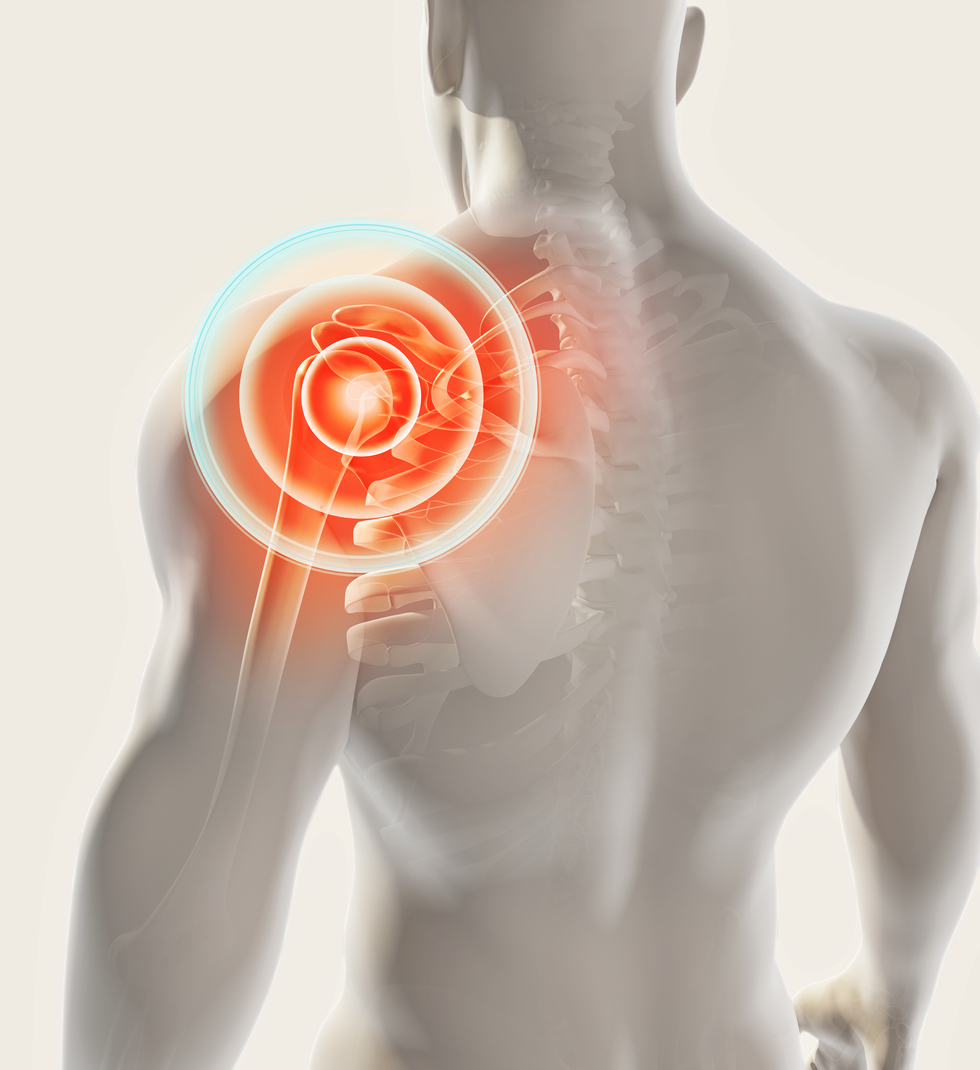Pain
What Is Shoulder Pain?

The shoulder is a complex combination of bones, joints, ligaments, muscles and tendons. Three bones meet at the shoulder to create a 90-degree angle: the clavicle (collarbone), scapula (shoulder blade), and humerus (upper arm bone). These three bones meet the sternum (breastbone) to create three joints: the glenohumeral joint, acromioclavicular (AC) joint, and sternoclavicular joint.
A large portion of shoulder issues result from the breakdown of soft tissue located in the shoulder area. The region experiencing shoulder pain can vary from a small area, a broad area, or the entire arm. Shoulder pain can range from mild to severe.
Rotator cuff
The rotator cuff is composed of a group of muscles and tendons. It stabilizes the shoulder and holds the bones in place. It also allows the shoulder to move in a circular motion. The rotator cuff is made up of four muscles: the supraspinatus, infraspinatus, teres minor, and subscapularis. Tears and inflammation are the two main categories of rotator cuff problems.
Causes
Referred pain can occur in the shoulder due to an injury at another location, usually the neck or bicep. Pain that reaches the shoulder due to a nerve may be a result of a disease, such as heart disease, liver disease, gallbladder disease, or a neck or spine disease. There are various other causes of shoulder pain, which include, but are not limited to, the following:
- Avascular necrosis (death of bone tissue due to limited blood flow)
- Arthritis
- Bone spurs
- Brachial plexus injury
- Broken collarbone
- Bursitis (joint inflammation)
- Cervical radiculopathy
- Dislocation
- Fractured arm or shoulder
- Frozen shoulder
- Heart attack
- Impingement syndrome (top outer edge of the shoulder blade rubs or pinches the rotator cuff)
- Injury
- Osteoarthritis
- Pinched nerve in the neck or shoulder
- Polymyalgia rheumatica
- Rheumatoid arthritis
- Rotator cuff injury or tear
- Septic arthritis
- Shoulder separation
- Spinal cord injury
- Sprains
- Tendinitis
- Tendon rupture
- Thoracic outlet syndrome
- Torn cartilage
Risk factors
Shoulder issues can affect people of all ages, races, ethnic backgrounds, and genders. The risk of developing shoulder pain increases with the following:
- Repetitive movement
- Overuse
- Older age
- Playing sports
- Performing manual labor
Diagnosing
Issues with the shoulder are typically diagnosed by a health care professional with a medical history, physical examination, and various tests. Testing may include x-rays, magnetic resonance imaging (MRI), and ultrasounds.
Treatments
The treatment of shoulder pain varies depending on the diagnosis. The most common shoulder ailments and their treatments include the following:
- Arthritis of the shoulder is typically either osteoarthritis or rheumatoid arthritis. Osteoarthritis is most commonly treated with non-steroidal anti-inflammatory drugs (NSAIDs), including ibuprofen and aspirin. Rheumatoid arthritis also requires medication, such as corticosteroids, and sometimes physical therapy.
- Bone fractures are cracks that range from breaking through the entire bone to a small, hairline fracture. Treatment may include movement of the bone back into the proper position to facilitate healing, immobilization of the broken bone in a sling or other apparatus, physical therapy, and possibly surgery.
- Dislocation is treated by a health care professional pushing the ball of the upper arm back into the socket. Afterwards, a sling or another apparatus may be used to immobilize the shoulder. Rest, ice, and specific exercises to strengthen muscles and increase the range of motion are also beneficial.
- Rotator cuff inflammation or tears may result from overuse or aging. Treatment for injuries to the rotator cuff involve rest, ice, and over-the-counter pain medications to relieve swelling. In addition, cortisone injections, electrical stimulation or ultrasound, gentle stretching, and strengthening exercises can relieve pain. If the rotator cuff does not improve with the aforementioned treatments, surgery may be required.
- Separation of the shoulder occurs when the ligaments between the shoulder blade and collarbone are torn. Treatment includes rest, immobilization of the shoulder via a sling, ice, exercise, and possible surgery in the case of severe tears.
- A frozen shoulder is a unique ailment that restricts shoulder movement. Treatment for a frozen shoulder includes gentle stretching exercises, heat therapy, medication to diminish swelling and pain, cortisone injections, electrical stimulation of the nerves and muscles, physical therapy, and possible surgery.






